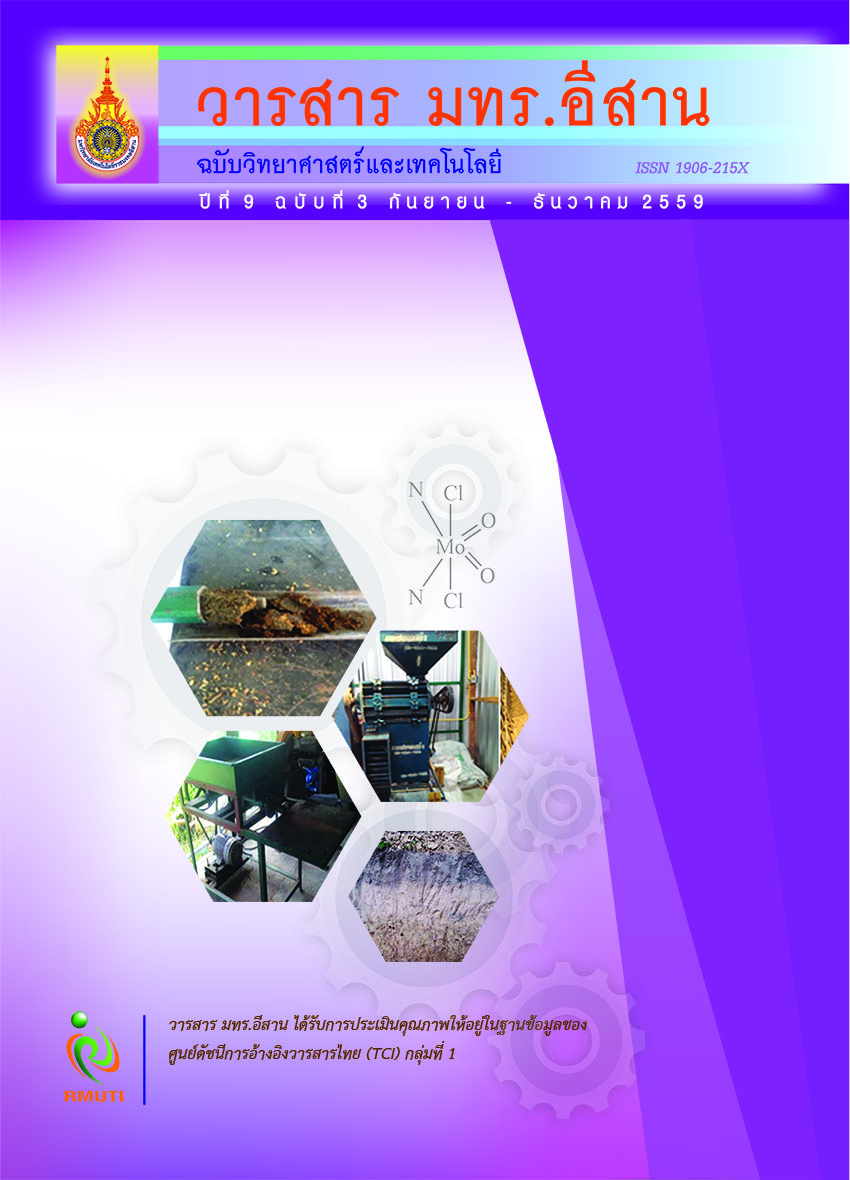การเปรียบเทียบการไหลเชิงตัวเลขของกังหันหัวนํ้าตํ่ามากโดยใช้ RANS และ LES Comparison of Flow Simulation of Very Low Head (VLH) Turbine Using RANS and LES
Main Article Content
Abstract
บทคัดย่อ
ดว้ ยขอ้ จำกัดดา้ นทรัพยากรคอมพิวเตอรส์ มรรถนะสูงและเวลาซีพียู (CPU Time) ที่ตอ้ งใชอ้ ยา่ งมีประสิทธิภาพ
การเลือกใชวิ้ธีการคำนวณเชิงตัวเลขที่เหมาะสมจึงเปน็ สิ่งที่จำเปน็ มาก ดังนั้นวัตถุประสงคง์ านนี้คือการศึกษา
เปรียบเทียบผลการคำนวณการไหลภายในกังหันหัวน้ำต่ำมาก (VLH Turbine) ที่ความเร็วใบพัด 200 รอบตอ่ นาที
กับระดับหัวน้ำ 2 เมตร ด้วยแบบจำลองของการไหลปั่นป่วนแบบ RANS (realizable k- ) ที่สภาวะ
การไหลคงที่ เปรียบเทียบกับแบบ LES (Smagorinsky-Lilly) ที่สภาวะการไหลไม่คงที่ เพื่อหาข้อสรุปผล
ความแตกตา่ งเฉลี่ยของอัตราการไหล หัวน้ำรวม และแรงบิด ที่สง่ ผลตอ่ คา่ ความแตกตา่ งเฉลี่ยของประสิทธิภาพ
และกำลังการผลิตของกังหัน งานวิจัยนี้จึงไดใ้ ชเ้ ทคนิคการสุม่ ลูกบาศกห์ ลายมิติแบบลาตินสำหรับการออกแบบ
การทดลอง 30 รูปแบบกลุ่มตัวอย่าง ด้วยการปรับมุมระหว่างไกด์เวนและใบพัด พบว่าผลเปรียบเทียบกัน
ระหว่าง 2 แบบจำลองของการไหลปั่นป่วน ให้ค่าความแตกต่างเฉลี่ยของอัตราการไหลและหัวนํ้ารวม
มีค่าตํ่ากว่า 1% ผลต่างแรงบิดไม่เกิน 2% โดยส่งผลให้ค่าความแตกต่างเฉลี่ยของประสิทธิภาพและกำลัง
การผลิตของกังหันประมาณ 3% ซึ่งจากผลตา่ งเชิงตัวเลขที่พบอาจสรุปไดว้ า่ ผลการใชแ้ บบจำลองของการไหล
ปนั่ ปว่ นแบบ RANS (realizable k- ) และแบบ LES (Smagorinsky-Lilly) ใหค้ า่ แตกตา่ งอยา่ งไมมี่
นัยสำคัญมากนัก แบบจำลองของการไหลปนั่ ปว่ นแบบ RANS (realizable k- ) จึงเป็นอีกทางเลือก
ที่เหมาะสมสำหรับกังหันหัวน้ำต่ำมาก เมื่อเทียบกับการใชท้ รัพยากรคอมพิวเตอรแ์ ละเวลาประมวลผลที่นอ้ ยกวา่
Abstract
Due to the limitation of computer resources, the efficient numerical method is necessary.
Thus, the objective of this study was to compare the computational results of a very low
head turbine (VLH turbine) flow at the runner speed of 200 rpm and the water head
level of 2 meters between the steady state turbulence model of RANS (realizable k- )
and the LES (Smagorinsky-Lilly) for the unsteady state. In order to identify the different
results of the flow rate, the total head and the torque that affect the efficiency and the
power output of the turbine, this research has used the Latin hypercube sampling
technique for experimental design of 30 models by adjusting the angles between the
guide vane and runner blade. By comparing the results of the two turbulent models,
it was found that the difference between both models for the flow rate and the total head
were less than 1%, and less than 2% for torque. The difference was less than 3% for the
numerical results of power output and efficiency. It could be concluded that the
difference of the numerical results using both turbulent models was not significant.
Thus the turbulence model of RANS (realizable k- ) is appropriated for VLH turbine
flow simulation when computer resources and time consumption are concerned.
Article Details
References
[2] Kaniecki, M., Krzemianowski, Z. and Banaszek, M. (2011). Computational Fluid Dynamics Simulations of Small Capacity Kaplan Turbines. Transactions of the Institute of Fluid-Flow Machinery. No. 123. pp. 71-84
[3] Yang, W., Wu, Y. and Liu, S. (2011). An Optimization Method on Runner Blades in Bulb Turbine Based on CFD Analysis. Science China Technological Sciences. Vol. 54. No. 2. pp. 338-344
[4] Ge, X., Feng, Y., Zhou, Y., Zheng, Y. and Yang, C. (2013). Optimization Study of Shaft Tubular Turbine in a Bidirectional Tidal Power Station. Advances in Mechanical Engineering. Vol. 2013. pp. 1-9
[5] Yang, C., Zheng, Y., Zhou, D., Ge, X. and Li, L. (2013). Bidirectional Power Performance of a Tidal Unit with Unilateral and Double Guide Vanes. Advances in Mechanical Engineering. Vol. 2013. pp. 1-11
[6] Sutikno, P. and Adam, I. K. (2011). Design, Simulation and Experimental of the Very Low Head Turbine with Minimum Pressure and Free Vortex Criterions. International Journal of Mechanical and Mechanics Engineering. Vol.11. No. 1. pp. 9-16
[7] Su, W.-T., Li, F.-C., Li, X.-B., Wei, X.-Z. and Zhao, Y. (2012). Assessment of Les Performance in Simulating Complex 3D Flows in Turbo-Machines. Engineering Applications of Computational Fluid Mechanics. Vol. 6. No. 3. pp. 356–365
[8] Liu, C., Liu, C. and Ma, W. (2015). Rans, Detached Eddy Simulation and Large Eddy Simulation of Internal Torque Converters Flows: A Comparative Study. Engineering Applications of Computational Fluid Mechanics. Vol. 9. No. 1. pp. 114-125
[9] Pholdee, N. (2013). Performance Enhancement of Evolutionary Optimisation Using Hybridsation Concepts. Ph.D. Thesis, Department of Mechanical Engineering, Faculty of Engineering, Khon Kaen University
[10] Bureerat, S. (2013). Optimization of Mechanical Engineering System. Vol. 1. Khon Kaen: Khon Kaen University
[11] Cable, M. (2009). An Evaluation of Turbulence Models for the Numerical Study of Forced and Natural Convective Flow in Atria. Master Thesis, Department of Mechanical and Materials Engineering, Queen’s University
[12] Reza, Z. (2010). Dissipation and Eddy Mixing Associated with Flow Past an UnderWater Turbine. Master Thesis, Faculty of the College of Engineering and Computer Science, Florida Atlantic University
[13] M. Ramos, H., Sim o, M. and Borga, A. (2013). Experiments and CFD Analyses for a New Reaction Microhydro Propeller with Five Blades. Journal of Energy Engineering. Vol. 139. pp. 109-117


